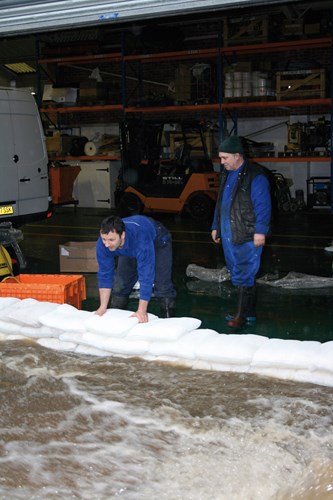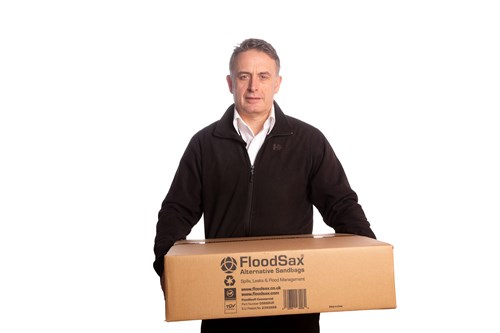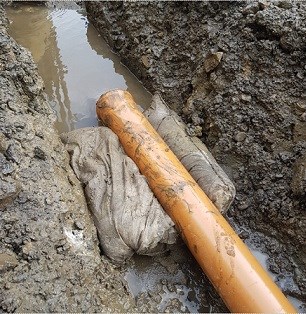The FloodSax® will then expand in around five minutes to weigh 20kg (44lbs). If you use warm water the FloodSax® will expand even quicker in around 3 minutes. A special gelling polymer inside simply absorbs the water and then keeps it in the FloodSax® so it can be used for however long the emergency lasts, which could be several months.
Each row of FloodSax® will keep out approximately 6 inches of water and usually two or three rows are enough to keep floodwater out. Just lay the FloodSax® next to one another and then the row on top across the joins below to make it a firm barrier. FloodSax® are so heavy and tough, water blasted at them through a firefighting hose won’t shift them.
During torrential rain a row of FloodSax® two high kept a deluge of floodwater out of a company’s warehouse. The business had previously been flooded in the warehouse which had led to a $354,000 insurance claim and when the FloodSax® kept the floodwater at bay there was high technology electrical equipment valued at more than $500,000 in the warehouse. The FloodSax® stopped any water from getting in and damaging the equipment.

To discover the 10 wettest states in the USA simply click here.
And if you've ever wondered which are the wettest cities in the US click here.
FloodSax® factfile including sizes and weights
Each FloodSax® is made up of 4 layers with 12 internal absorbent sections creating a multi-chamber system to keep the water fully absorbed. These absorbent chambers are then sewn together into an outer sleeve of a nonwoven material.
Each FloodSax® weighs just under 1lb (0.39 kilos) before it comes into contact with water and is 52cms by 53cms by 1.5cms in size. After it has absorbed the water it will be about 20cms deep and the same length and width.
A box of 20 FloodSax® weighs just 21lbs (9.5kilos) and is 55cms by 54cms by 15cms so can easily be carried by one person. They would struggle to carry just one sandbag.

Disposing of FloodSax®
FloodSax® alternative sandbags should be disposed of once they have been used to stop flooding … and the same goes for traditional sandbags.
This is because floodwater is always contaminated and this could range from sewage and chemicals to fuel and oil.
Most of this inner material within a FloodSax® - the gelling polymer and wood pulp - is biodegradable so if you want to shrink the FloodSax® after use cut across it diagonally from corner to corner with a knife and then pour table salt on the white inners which will break down the polymer.
This reduces the size of the FloodSax® which can then be thrown into the general waste to go to landfill where most of it will biodegrade over time. If short of time, the FloodSax® can be thrown away without cutting it across and adding the salt.
Always wear gloves to reduce the risk of contamination.

Buying FloodSax® couldn't be easier. Simply go to https://www.amazon.com/dp/B019C6C578/